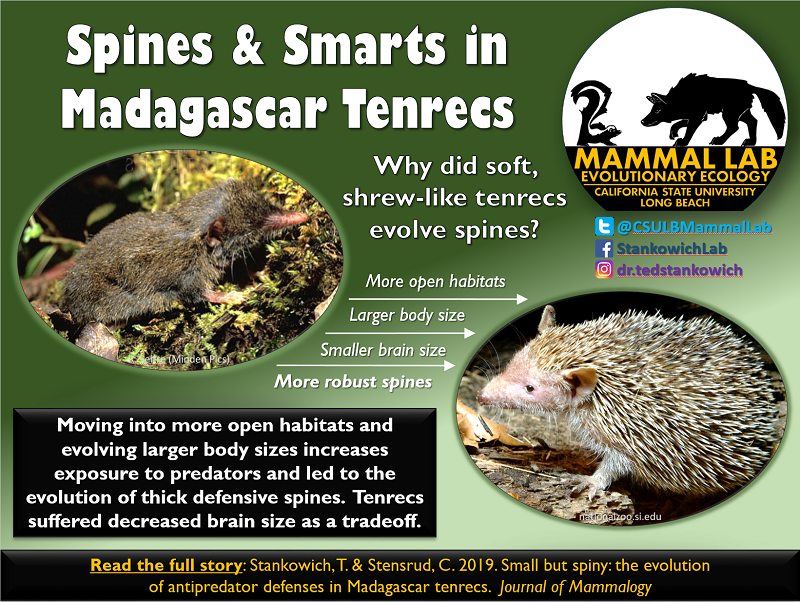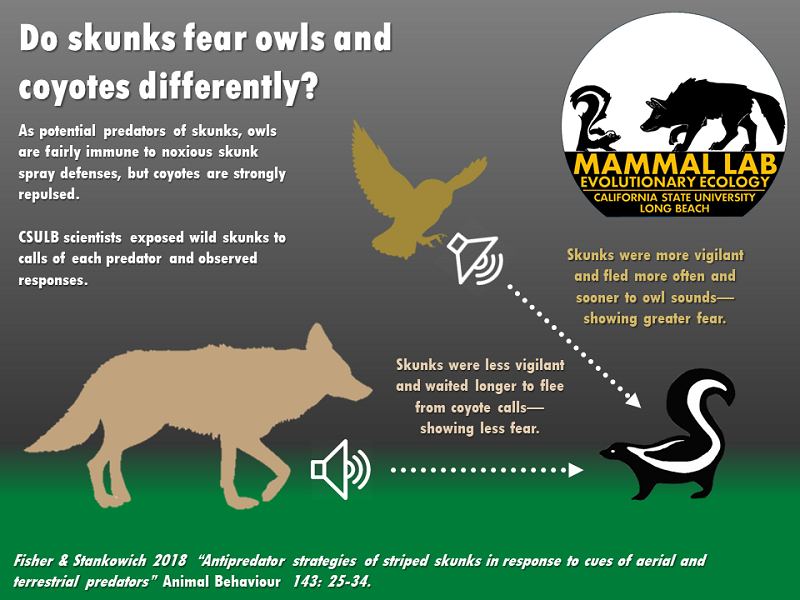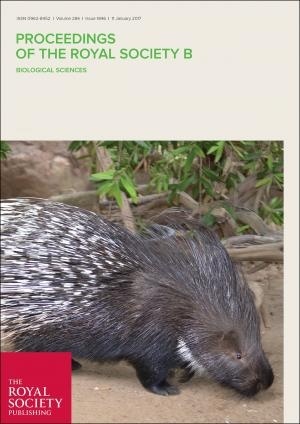Publications
Reprints of all publications also available via e-mail if you don't have institutional access via the posted links. Just contact us!
CSULB Student
73. Lopez, N. & Stankowich, T. Accepted. Territoriality, sociality and male weaponry shape horn investment in female bovids. Behavioral Ecology.
72. McLean, B.S., Bloom, D., Davis, E.B., Guralnick, R.P., Santana, S.E., Allen, J.M., Amarilla-Stevens, H., Bell, K.C., Blackburn, D.C., Bradley, J.E., Bradley, R.D., Carling, M.D., Coconis, A., Colella, J.P., Conroy, C.J., Cook, J.A., Cruz Machado, H.d.B., Demboski, J.R., Derieg, K.M., Doll, A., Dumbacher, J.P., Duncan, W.D., Dunnum, J.L., Feldman, C., Ferguson, A.W., Fitzgerald, K.E., Flannery, M.E., Hood, K., Hornsby, A.D., Krejsa, D., LaFrance, R., Light, J.E., Pavan, S.E., Peterson, S., Raniszewski, A., Rickart, E.A., Robson, S., Rowe, R.J., Rowsey, D.M., Semerdjian, A., Stankowich, T., Steger, L., Stevens, R., Thibault, K.M., Thompson, C.W., Upham, N.S., Wilkins, A., & Wommack, E.A. 2025. Extending mammal specimens with their essential phenotypic traits. Journal of Mammalogy, gyaf062. Reprint.
71. Teeple, J.B., Cohen, K.E., Stankowich, T., Paig-Train, E.W.M., & Donatelli, C.M. In Press. The armadillo's guide to damage control: The mechanics of osteoderms and hard-soft interactions. Integrative and Comparative Biology.
70. Cohen, K.E., Donatelli, C.M., Schulz, A.K., Teeple, J.B., Stankowich, T., & Paig-Train, E.W.M. 2025. Biological Armors – Evolution, Materials, and Bioinspiration. Integrative and Comparative Biology, icaf074. Reprint.
69. Devarajan, K., Fidino, M., Farris, Z.J., Adalsteinsson, S.A., Andrade-Ponce, G., …+179 additional authors in alpha order… St. Clair, C.C., Stankowich, T., Steinmetz, R., Stevenson, C.J., Sunarto, Surasinghe, T.D., Sutyrina, S.V., Swaisgood, R.R., Taktehrani, A., Thapa, K., Thorton, M., Tilker, A., Tobler, M.W., Van Bang, T., Tucker, J., Van Horn, R.C., Vargas-Soto, J.S., Velásquez-C, K.L., Venter, J., Venticinque, E.M., Verschueren, S., Wampole, E., J Watchorn, D., Wearn, O.R., Weiss, K.C., Welschen, A., Widodo, F.A., Williamson, J., Wilting, A., Wittemeyer, G., Zavaleta, A., Zellmer, A.J., & Gerber, B.D. 2025. When the wild things are: defining mammalian diel activity and plasticity. Science Advances, 11(9), 1-15, eado3843. Reprint.
68. Larson, R.N., Sander, H.A., Fidino, M., Angstmann, J.L., Hursh, S.H., Magle, S.B., Moore, K., Salsbury, C.M., Stankowich, T., Tombs, K., Barczak, L., Davidge, A.M., Drake, D., Hartley, L., Sanchez, P.R., Robey, A., Snyder, T., Williamson, J., & Zellmer, A.J. 2024. Patterns in tree squirrel co-occurrence vary with responses to local land cover in US cities. Urban Ecosystems, 27, 2121-2133. Reprint.
67. Fay, C., Young, J.K., & Stankowich, T. 2024. Aposematic learning in a mammalian predator-prey system. Animal Behaviour, 212, 39-48. Reprint.
66. Fidino, M., Sander, H.A., Lewis, J.S., Lehrer, E.W., Rivera, K., Murray, M.H., Adams, H.C., Kase, A., Flores, A., Stankowich, T., Schell, C.J., Salsbury, C.M., Rohnke, A.T., Jordan, M.J., Green, A.M., Gramza, A.R., Zellmer, A.J., Williamson, J., Surasinghe, T.D., Storm, H., Sparks, K.L., Ryan, T.J., Remine, K.R., Pendergast, M.E., Mullen, K., Minier, D.E., Middaugh, C.R., Mertl, A.L., McClung, M.R., Long, R.A., Larson, R.N., Kohl, M.T., Harris, L.R., Hall, C.T., Haight, J.D., Drake, D., Davidge, A.M., Cheek, A.O., Bloch, C.P., Biro, E.G., Anthonysamy, W.J.B., Angstmann, J.L., Allen, M.L., Adalsteinsson, S.A., Gianotti, A.G.S., LaMontagne, J.M., Gelmi-Candusso, T.A., & Magle, S.B. 2024. Gentrification drives patterns of alpha and beta diversity in cities. Proceedings of the National Academy of Sciences, 121(17), article e2318596121. Reprint
65. Lopez, N., Moore Tupas, J., & Stankowich, T. 2024. Brains vs brawn: Relative brain size is sexually dimorphic amongst weapon-bearing ruminants. Behavioral Ecology & Sociobiology, 78, article 11. Reprint
64. Rabitoy, H. & Stankowich, T. 2023. Effects of human approach directness and path use on small mammal risk perception. Journal of Ethology, 42, 19-29. Reprint
63. Walker, H., Caro, T., Bell, D., & Ferguson, A., Stankowich, T. 2023. Predation risk drives aposematic signal conformity. Evolution, 77(11), 2492-2503. Free Reprint
62. Haight, J.D., Hall, S.J., Fidino, M., Adalsteinsson, S.A., Ahlers, A.A., Angstmann, J., Anthonysamy, J.B., Biro, E., Collins, M.K., Dugelby, B., Gallo, T., Green, A.M., Hartley, L., Jordan, M.J., Kay, C.A.M., Lehrer, E.W., Long, R.A., MacDougall, B., Magle, S.B., Minier, D.E., Mowry, C., Murray, M., Nininger, K., Pendergast, M.E., Remine, K.R., Ryan, T., Salsbury, C., Schell, C.J., Șekercioğlu, Ç.H., Shier, C.J., Simon, K.C., St. Clair, C.C., Stankowich, T., Stevenson, T.J., Wayne, L., Will, D., Williamson, J., Wilson, L., Zellmer, & A.J., Lewis, J.S. 2023. Urbanization, climate, and species traits shape mammal communities from local to continental scales. Nature Ecology & Evolution, 7, 1654–1666. Reprint, Nature News & Views article.
61. Kikuchi, D.W., Allen, W.L., Arbuckle, K., Aubier, T.G., Briolat, E.S., Burdfield-Steel, E.R., Cheney, K.L., Daňková, K., Elias, M., Hämäläinen, L., Herberstein, M.E., Hossie, T.J., Joron, M., Kunte, K., Leavell, B.C., Lindstedt, C, Lorioux-Chevalier, U., McClure, M., McLellan, C.F., Medina, I., Nawge, V., Páez, E., Pal, A., Pekár, S. Penacchio, O., Raška, J., Reader, T., Rojas, B., Rönkä, K.H., Rößler, D.C., Rowe, C., Rowland, H.M., Roy, A., Schaal, K.A., Sherratt, T.N., Skelhorn, J., Smart, H.R., Stankowich, T., Stefan, A.M., Summers, K., Taylor, C.H., Thorogood, R.T., Umbers, K., Winters, A.E., Yeager, J., & Exnerová, A. 2023. The evolution and ecology of multiple antipredator defences. Journal of Evolutionary Biology, 36(7), 975-991. Reprint
60. Reed, P.M., Dwyer, J.F., & Stankowich, T. 2023. Supplementation of seasonal natural resources with year-round anthropogenic resources by coyotes in natural fragments within a high-density urban area. Wildlife Biology, 2023(4), e1095. Reprint
59. Lopez, N. & Stankowich, T. 2023. Sizing up swords: Correlated evolution of antlers and tusks in ruminants. Journal of Mammalian Evolution, 30, 231-244. Reprint
58. Gallo, T., Fidino, M., Gerber, B., Ahlers, A.A., Angstmann, J.L., Amaya, M., Concilio, A.L., Drake, D., Gay, D., Lehrer, E.W., Murray, M.H. Ryan, T.J., St. Clair, C.C., Salsbury, C.M., Sander, H.A., Stankowich, T., Williamson, J., Belaire, J.A., Simon, K., & Magle, S.B. 2022. Mammals adjust diel activity across gradients of urbanization. eLife, 11, e74756. Reprint
57. Caro, T., Brockelsbury, K., Ferrari, A., Koneru, M., Ono, K., Rowe, Z.W., Touche, E., Walker, H., & Stankowich, T. 2022. On the evolution of distinctive natal coat coloration in primates. American Journal of Biological Anthropology, 177(3), 530-539. Reprint
56. Kay, C.M., Rohnke, A., Sander, H., Stankowich, T., Fidino, M., Murray, M., Lewis, J., Taves, I., Lehrer, E., Zellmer, A., Schell, C., & Magle, S. 2022. Barriers to building wildlife-inclusive cities: Insights from the deliberations of urban ecologists, urban planners, and landscape designers. People and Nature, 4(1), 62-70. Reprint.
55. Magle, S., Fidino, M., Sander, H.A., Rohnke, A.T., Larson, K.L., Gallo, T., Kay, C.A.M., Lehrer, L., Murray, M.H., Adalsteinsson, S.A., Ahlers, A.A., Anthonysamy, W.J.B., Gramza, A.R., Green, A.M., Jordan, M.J., Lewis, J.S., Long, R.A., MacDougall, B., Pendergast, M.E., Remine, K., Simon, K.C., St. Clair, C.C., Stankowich, T., Zellmer, A.J., & Schell, C.J. 2021. Wealth and urbanization shape medium and large terrestrial mammal communities. Global Change Biology, 17(21), 5446-5459. Reprint
54. Crofts, S.B. & Stankowich, T. 2021. Stabbing Spines: A review of the biomechanics and evolution of defensive spines. Integrative and Comparative Biology, 61(2), 655–667. Reprint
53. Caro, T. & Stankowich, T. 2021. A roadmap for comparative primate coloration research: a response to comments on Caro et al. Behavioral Ecology, 32(4), 572–573. Reprint
52. Caro, T., Brockelsby, K., Ferrari, A., Koneru, M., Ono, K., Touche, E., Stankowich, T. 2021. The evolution of primate coloration revisited. Behavioral Ecology, 32(4), 555–567. INVITED REVIEW WITH COMMENTARIES Reprint
51. Fidino, M., Gallo, T., Lehrer, E.W., Murray, M.H., Kay, C.A.M., Sander, H.A., MacDougall, B., Salsbury, C.M., Ryan, T.J., Angstmann, J.L., Belaire, J.A., Dugelby, B., Schell, C.J., Stankowich, T., Amaya, M., Drake, D., Hursh, S.H., Ahlers, A.A., Williamson, J., Hartley, L.M., Zellmer, A.J., Simon, K., & Magle, S. 2020. Landscape-scale differences among cities alter common species' responses to urbanization. Ecological Applications, 27(21), 5446-5459. Reprint
50. Caro, T., Raees, H. & Stankowich, T. 2020. Flash behavior in mammals? Behavioral Ecology and Sociobiology, 74, article 44. Reprint
49. Cabrera, D. & Stankowich, T. 2020. Stabbing slinkers: Tusk evolution among terrestrial artiodactyls. Journal of Mammalian Evolution, 27(2), 265-272. Reprint
48. Stankowich, T. & Stensrud, C. 2019. Small but spiny: the evolution of antipredator defenses in Madagascar tenrecs. Journal of Mammalogy, 100(1), 13-20. Reprint

Research shows that small soft furred tenrecs evolved to live in more open habitats, have larger body sizes, have smaller brain sizes, and have more robust spines. Moving into more open habitats and evolving larger body sizes increases exposure to predators and led to the evolution of thick defensive spines. Tenrecs suffered decreased brain size as a tradeoff. To read the full story, see our publication: Stankowich and Stensrud, 2019. "Small but spiny: the evolution of antipredator defenses in Madagascar tenrecs" in the Journal of Mammalogy
47. Stankowich, T. 2019. Invited Review (The Dama Gazelles, Mungal, C., ed.). Quarterly Review of Biology, 94, 217-218.
46. Stankowich, T. 2019. Defensive Risk-Taking in Animals. In: Encyclopedia of Animal Behavior, 2nd ed., Choe, J. C., ed., Antipredator Behavior Section, Stankowich, T., section ed., Oxford University Press. Currently available in the Reference Module in Life Sciences. Reprint Defensive Risk-Taking in Animals
45. Briolat, E., Burdfield-Steel, E., Paul, S., Ronka, K., Seymoure, B., Stankowich, T. & Stuckert, A. 2019. Diversity in warning coloration: Selective paradox or the norm? Biological Reviews, 94, 388-414. Reprint Diversity in warning coloration: Selective paradox or the norm
44. Caro, T., Newell, C., & Stankowich, T. 2018. Ecocorrelates of pelage coloration in pigs and peccaries. Journal of Mammalogy, 99(5): 1093-1100. Reprint Ecocorrelates of pelage coloration in pigs and peccaries
43. Fisher, K.A. & Stankowich, T. 2018. Antipredator strategies of striped skunks in response to cues of aerial and terrestrial predators. Animal Behaviour, 143, 25-34. Reprint Antipredator strategies of striped skunks in response to cues of aerial and terrestrial predators

As potential predators of skunks, owls are fairly immune to noxious skunk spray defenses, but coyotes are strongly repulsed. CSULB scientists exposed wild skunks to calls of each predator and observed responses. Skunks were less vigilant and waited longer to flee from coyote calls--showing less fear. Skunks were more vigilant and fled more often and sooner to owl sounds--showing greater fear. Read about the work in Fisher and Stankowich 2018. "Antipredator strategies of striped skunks in response to cues of aerial and terrestrial predators." in Animal Behavior, Volume 143, pages 25-34
42. Broeckhoven, C., Adakc, Y.E., Hui, C., Van Damme, R., & Stankowich, T. 2018. On dangerous ground: the evolution of body armour in cordyline lizards. Proceedings of the Royal Society B, 285: 20180513. Reprint On dangerous ground: the evolution of body armour in cordyline lizards
41. Caro, T., Walker, H., Santana, S. E. & Stankowich, T. 2017. The evolution of anterior coloration in carnivorans. Behavioral Ecology and Sociobiology, 71:177. Reprint The evolution of anterior coloration in carnivorans
40. Caro, T., Walker, H., Rossman, Z., Hendrix, M. & Stankowich, T. 2017. Why is the giant panda black and white? Behavioral Ecology, 28(3), 657-667. Reprint Why is the giant panda black and white

39. Stankowich, T. & Romero, A. N. 2017. The correlated evolution of antipredator defences and brain size in mammals. Proceedings of the Royal Society B, 284, 1-7. Reprint The correlated evolution of antipredator defences and brain size in mammals
38. Buesching, C. D. & Stankowich, T. 2017. Communication amongst the Musteloids: Signs, signals, and cues. In: The Biology and Conservation of Wild Mustelids, Macdonald, D. W., Newman, C., & Harrington, L. A., eds., pp.158-177, Oxford University Press. E-mail for Reprint
37. Stankowich, T. & Campbell, L. A. 2016. Living in the danger zone: Exposure to predators and the evolution of spines and body armor in mammals. Evolution, 70(7), 1501-1511. Reprint Living in the danger zone: Exposure to predators and the evolution of spines and body armor in mammals
36. Schiefelbein, H. & Stankowich, T. 2016. Aversive or attractive? The effects of skunk oil on predator behavior. Proceedings of the 27th Vertebrate Pest Conference. Timm, R. M. & Baldwin, R. A., eds., pp. 52-58, UC Davis Press. E-mail for Reprint
35. Jones, C., Stankowich, T. & Pernet, B. 2016. Allocation of cytoplasm to macromeres in embryos of annelids and molluscs is positively correlated with egg size. Evolution and Development, 18(3), 156-170. Reprint Allocation of cytoplasm to macromeres in embryos of annelids and molluscs is positively correlated with egg size
34. Caro, T. & Stankowich, T. 2015. Concordance on zebra stripes. Royal Society Open Science, 2(9), 1-4. REPRINT
33. Samia, D. S. M., Møller, A. P., Blumstein, D. T., Stankowich, T. & Cooper, W. E. 2015. Sex differences in lizard escape decisions vary with latitude, but not sexual dimorphism. Proceedings of the Royal Society B, 282. REPRINT.
32. Samia, D. S. M., Blumstein, D. T., Stankowich, T. & Cooper, W. E. 2015. Fifty years of chasing lizards: new insights advance optimal escape theory. Biological Reviews, 91(2), 349-66. REPRINT.
31. Stankowich, T. & Reimers, E. 2015. Escape decisions in mammals. In: Escaping from Predators: An integrative view of escape decisions and refuge use. Cooper, W. E. & Blumstein, D. T., eds., Cambridge University Press.
30. Blumstein, D. T., Samia, D. S. M., Stankowich, T. & Cooper, W. E. 2015. Best practice for the study of escape behavior. In: Escaping from Predators: An integrative view of escape decisions and refuge use. Cooper, W. E. & Blumstein, D. T., eds., Cambridge University Press.
29. Caro, T., Izzo, A., Reiner, B., Walker, H., Stankowich, T. 2014. The function of zebra stripes. Nature Communications, 5, article 3535. REPRINT.
28. Stankowich, T., Haverkamp, P. J., Caro, T. 2014. Ecological drivers of antipredator defenses in carnivores. Evolution, 68(5), 1415-1425. REPRINT.
27. Stankowich, T. 2014. Predation and Antipredator Behavior. In: Animal Behavior: How and Why Animals Do the Things They Do, Vol. 2: Function & Evolution of Behavior, Yasukawa, K., ed., Praeger. REPRINT.
26. Weston, M. A. & Stankowich, T. 2014. Dogs as agents of disturbance. In: Free-Ranging Dogs and Wildlife Conservation, Goempper, M. E., ed., Oxford University Press, p. 94-116. REPRINT.
25. Caro, T., Stankowich, T., Kiffner, C., Hunter, J. 2013. Are spotted skunks conspicuous or cryptic? Ethology, Ecology & Evolution, 25(2), 144-160. REPRINT.
24. Caro, T., Stankowich, T., Mesnick, S., Costa, D., Beeman, K. 2012. Pelage coloration in pinnipeds: functional considerations. Behavioral Ecology, 23(4), 765-774. REPRINT.
23. Stankowich, T. 2012. Armed and dangerous: predicting the presence and function of defensive weaponry in mammals. Adaptive Behavior (Special Issue: "Predator-Prey Interactions"), 20(1), 34-45. REPRINT
22. Stankowich, T., Caro, T., Cox, M. 2011. Bold coloration and the evolution of aposematism in terrestrial carnivores. Evolution, 65(11), 3090-3099. REPRINT.
21. Caro, T., Beeman, K., Stankowich, T., Whitehead, H. 2011. The functional significance of colouration in cetaceans. Evolutionary Ecology, 25, 1231-1245. REPRINT.
20. Cooper, W. E. & Stankowich, T. 2010. Prey or predator? Body size of an approaching animal affects decisions to attack or escape. Behavioral Ecology, 21(6), 1278-1284. REPRINT
19. Stankowich, T. 2010. Risk-taking in self-defense. In: Encyclopedia of Animal Behavior, Breed, M. D. & Moore, J., eds., Antipredator Behavior Section, Stankowich, T., section ed., Academic Press, Oxford, Vol. 3, p. 79-86. REPRINT.
18. Caro, T. M. & Stankowich, T. 2010. The function of contrasting pelage markings in Artiodactyls. Behavioral Ecology, 21(1), 78-84. REPRINT.
17. Stankowich, T. & Caro, T. M. 2009. Evolution of weaponry in female bovids. Proceedings of the Royal Society B, 276, 4329-4334. REPRINT
16. Fernandez-Juricic, E., Zahn, E.F., Parker, T., Stankowich, T. 2009. Tolerance to pedestrian disturbance of the California endangered Belding's Savannah Sparrow (Passerculus sandwichensis beldingi). Avian Conservation and Ecology, 4(2), 1 [online]. REPRINT
15. Blumstein, D.T., Ferando, E., Stankowich, T. 2009. A test of the multi-predator hypothesis: Yellow-bellied marmots respond fearfully to the sight of novel and extinct predators. Animal Behaviour, 78, 873-878. REPRINT
14. Stankowich, T. 2009. When predators become prey: flight decisions in jumping spiders. Behavioral Ecology, 20(2), 318-327. REPRINT
13. Stankowich, T. 2009. Invited review (The Better to Eat You With: Fear in the Animal World, Berger 2008). Quarterly Review of Biology, 84(3), 298.
12. Stankowich, T. 2008. Ungulate flight responses to human disturbance: a review and meta-analysis. Biological Conservation, 141(9), 2159-2173. REPRINT
11. Stankowich, T. 2008. Tail-flicking, tail-flagging, and tail position in ungulates with special reference to black-tailed deer. Ethology, 114(9), 875-885. REPRINT
10. Stankowich, T. & Coss, R. G. 2008. Alarm walking in Columbian black-tailed deer: its characterization and possible antipredatory signaling functions. Journal of Mammalogy, 89(3), 636-645. REPRINT
9. Stankowich, T. 2008. Invited Review (Quantifying Behavior the JWatcher Way, Blumstein & Daniel 2007). Integrative and Comparative Biology, 48(3), 437-439.
8. Stankowich, T. & Coss, R. G. 2007. Effects of risk assessment, predator behavior, and habitat on escape behavior in Columbian blacktailed deer. Behavioral Ecology, 18(2), 358-367. REPRINT
7. Stankowich, T. & Coss, R. G. 2007. The re-emergence of felid camouflage with the decay of predator recognition in deer under relaxed selection. Proceedings of the Royal Society B, 274, 175-182. REPRINT
6. Stankowich, T. & Coss, R. G. 2006. Effects of predator behavior and proximity on risk assessment in Columbian blacktailed deer. Behavioral Ecology, 17(2), 246-254, REPRINT
5. Stankowich, T. & Blumstein, D. T. 2005. Fear in animals: a meta-analysis and review of risk assessment. Proceedings of the Royal Society B, 272, 2627-2634. REPRINT; ONLINE APPENDIX
4. Stankowich, T. 2003. Marginal predation methodologies and the importance of predator preferences. Animal Behaviour, 66, 589-599. REPRINT
3. Stankowich, T. 2003. Invited Review (The African Wild Dog, Creel & Creel 2002). Ethology, 109, 613-616.
2. Stankowich, T. & Sherman, P.W. 2002. Pup shoving behavior in adult naked mole rats. Ethology, 108, 975-992. REPRINT
1. Bell, A. M., Davis, J. M., Debose, J. L., Johnson, J. C., Long, S. L., Mabry, K. E., Stankowich, T. & Watters, J. V. 2002. Greatest hits in behavioral ecology. Trends in Ecology and Evolution, 17, 296.





